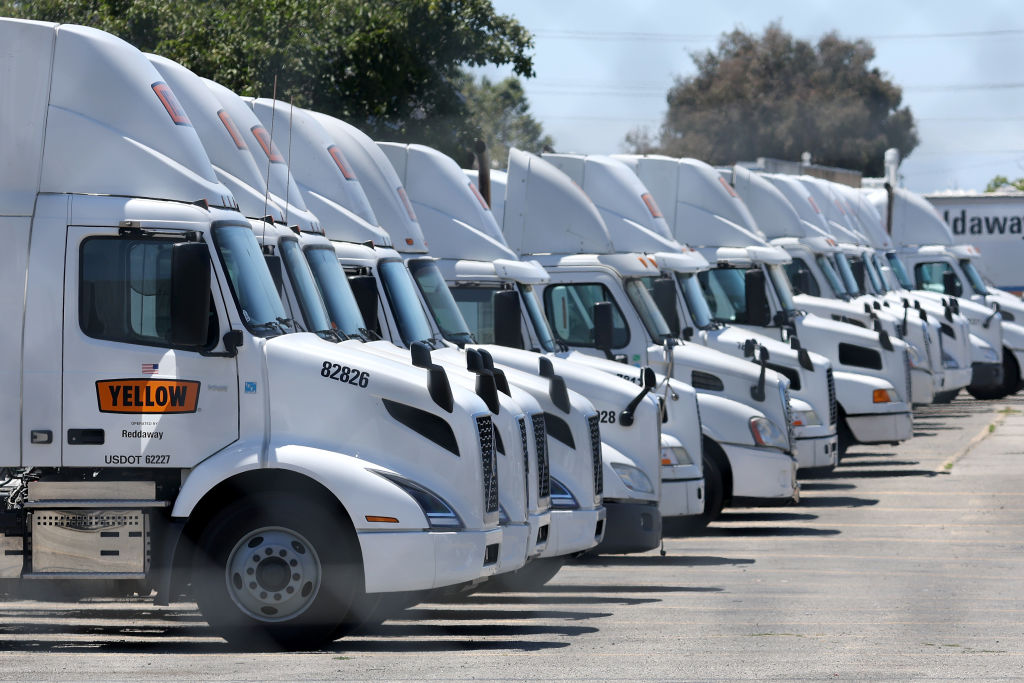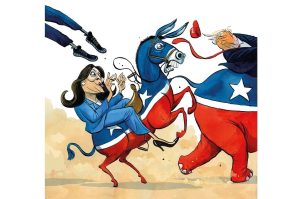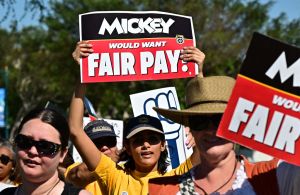It’s chic to look down on big trucks and their drivers. Former president Donald Trump’s photo op with truckers in 2017 was immediately lampooned on social media and by liberal journalists. It would be fitting, then, if the trucking industry provides the example that kills the push to rapidly move developed economies to “net zero” greenhouse gas emissions.
The fact is that any serious attempt to make Western economies “net zero” will be costly, technologically difficult and extremely disruptive to our way of life. Nothing captures these inconvenient truths better than the effort to force the electrification of the trucking industry.
Trucks are to the modern economy what the circulatory system is to the body. Trucks of all sizes move goods from one place to another much as our hearts, arteries and veins keep blood moving — our economic health depends on a rapid, inexpensive trucking industry.
This point was driven home to me last spring as I drove cross-country from Arizona. Most of the 700-mile distance between Phoenix and Amarillo, Texas, is wilderness, desert or just plain barren. Yet literally thousands of long-haul trucks passed me by as I traveled east. At one point I started counting them (also useful for keeping awake). A total of 1,768 westbound trucks went by in three hours, roughly ten per minute.
That count of course underestimates how many long-haul trucks ply America’s highways. That total was in just one direction, on one interstate highway, for part of an afternoon. America has five major East-West interstates connecting the West Coast to the rest of the country. Moreover, I was driving during daylight hours, while many truckers prefer to drive in the late evening when there are fewer cars on the road. It wouldn’t be surprising to learn that a hundred big-rig trucks per minute travel in both directions nationwide during peak hours just in the Western states.
That long-haul business is what feeds America’s insatiable appetite for imported goods, transporting them from ship to store. Roughly half of all US imported goods arrive in ports on the Pacific Coast, mostly in California. Some travel by rail but most are delivered by trucks. Upset the finely honed trucking industry just a little and stores don’t get stocked, prices go up and jobs are lost.
Recall the ruckus that the back-up of imported goods caused during the pandemic. Americans couldn’t go out to eat, travel or buy services because of lockdown restrictions, so they spent like sailors on things. Imports surged, leading to massive tie-ups at ports: ships couldn’t dock and truckers couldn’t get in or out with goods and containers. The supply-chain issues received considerable blame for the high inflation the country was experiencing.
Given this, you might think that climate-change advocates would go slow and consolidate their advances elsewhere before tackling this massive sector. You’d be wrong — and therein lies a cautionary tale.
California (of course) is leading the way. The state’s Air Resources Board has the authority to set its own emissions standards in some cases, and it is using that power to essentially force the rapid adoption of electric long-haul trucks. California’s efforts are complex and the subject of multiple lawsuits alleging it’s overstepped its legal mandate under the federal Clean Air Act. But the gist is simple: California aims to force manufacturers to build, fleet owners to use and truck operators to buy electric trucks as quickly as humanly possible.
That makes sense — if one looks at the world solely through the lens of climate change. But it’s heedlessly crazy when viewed through the broader lens of its economic impact.
The first problem comes from the sheer physics of vehicle refueling. Today’s diesel-fueled trucks can roll up to a gas station and fill their enormous tanks in only a few minutes. Then the truck can travel hundreds of miles before it needs to stop again.
Electric trucks, however, require hours to charge. That’s costly downtime for the truck owner — he still pays the driver plus any associated lodging and meal costs, and he has an expensive rig that’s not moving freight. With current technology, an electric truck would take days to cover the distance that now takes only hours.
Then there’s the problem of charging facilities. It’s one thing to build small charging stations in shopping-mall parking lots. That can help top off a car’s battery and keep the vehicle moving efficiently. But that can’t work out West. The thousands of gasoline-powered trucks now on the road don’t even have enough parking spots to accommodate mandated rest times. The nation is far short of what would be needed to efficiently accommodate tens of thousands of trucks for long hours of recharging every day.
That’s assuming you could build appropriate charging stations for enough spots even if the technology existed. This area is mountainous and unpopulated. And it’s not a matter of some rapidly installed underground tanks: along with charging stations themselves, there has to be electricity, and the grid was not built to transport large amounts of energy here. There aren’t enough electric power plants, much less sufficient substations and wiring, to quickly build the required infrastructure to satisfy California’s mandate. It makes little sense to require people to buy and operate trucks they cannot fuel on the road, but that doesn’t bother the Golden State’s climate czars.
There’s also the not-so-small problem of vehicle load and cost. Batteries are huge and heavy, and batteries large enough to power a big rig take up a lot of space that diesel vehicles use for cargo. The electric rigs also cost much more in the first place than traditional trucks.
Add all these factors together and you get a depressing result. America’s economic arteries will, if California gets its way, be choked by trucks that can’t carry the large loads they do today, take much longer to complete trips and cost owners more to buy and operate.
The only way to make this change work would be to dramatically increase shipping costs and slow down the just-in-time continuous-flow delivery model that modern inventory management is built on. That might be great for the climate, but it will wreak havoc on American businesses and American consumers, who will ultimately absorb the costs. The pandemic-era logistical difficulties could easily become a permanent feature of life.
Nor is this simply an American problem. Europe also relies on trucks to move roughly 70 percent of all freight traffic, and the continent’s focus on reducing greenhouse-gas emissions is placing trucks in the regulatory crosshairs there too. American Trucking Associations president Chris Spear recently told the EU Parliament to reject California’s pedal to the metal rush. Given the EU consensus on quickly getting to net zero, it is unclear if his warnings will be heeded.
The trucking example shows that rapid adoption of the climate agenda is in direct and unavoidable conflict with economic sanity. Adopting a reasonable approach — only pushing people to bear the costs they are willing to pay for, directly or indirectly — means slowing down the reduction in greenhouse gas emissions. Failing to understand that means forcing entire industries to undergo upheaval and will likely incur significant and unsustainable uncompensated losses.
Ironically, it could be California that sees the first direct impact of its own unworkable rules. Businesses are already shifting their imports and exports away from California’s ports. More could easily make that choice if they reason the state’s new mandates would mean that shipping their goods would no longer be guaranteed at a reasonable cost in money and time. That’s good news for ports like Charleston, Savannah and Houston, but it’s probably not what Governor Gavin Newsom wants to talk about as he burnishes his national profile.
Advocates for California’s approach contend that government mandates can force the technological advances needed to make electric long-haul trucks viable. That might be true in the long run, but it runs headlong into the strongly held belief that emission reduction has to take place rapidly to avoid catastrophic planetary warming. And the premise hasn’t worked in the past: California tried a similar approach to push the sales of zero-emission cars and light trucks starting in 1990. Over thirty years later, over 80 percent of new vehicles sold in the state were still fueled by traditional gas-powered engines.
There are already signs that people won’t pay the costs needed for the transformation climate warriors want. Dutch voters made a new party, the Farmer-Citizen Movement (BBB), the largest party in that nation’s Senate in 2023. Uproar over proposed climate regulations in Germany forced the three-party center-left government to water down a proposed law to require homeowners to buy expensive, climate-friendly heat pumps rather than gas-powered boilers. Recent polls in Canada show voters overwhelmingly dislike Prime Minister Justin Trudeau’s carbon tax, which they believe is helping to stoke inflation. Climate-change politics may seem to be an irresistible force, but it’s consistently getting smashed when it runs into voters’ immovable object — a preference to maintain their standard of living.
A sensible climate-change strategy would focus on subsidizing technological advances and less on mandating rapid change. Imagine if California were to offer huge subsidies for truck operators to buy today’s electric trucks while also subsidizing research that would produce smaller, more powerful batteries. That approach wouldn’t lead to rapid adoption of low-emitting vehicles. But it could mean cheaper, more economically viable trucks are available sooner than would otherwise be the case.
That’s why the proposed trucking mandates are so misguided. Trucking touches everything people buy today. Disrupt that foundation and the entire economy shakes. This California earthquake would rattle the entire nation.
The alternative, however, would run politically afoul of the climate warriors’ incendiary demands. Excited reports regularly claim that we have ten years or less to “save the planet.” True believers like Representative Alexandria Ocasio-Cortez understand that to imply the need for suspending the free-market economy and moving to a government-directed approach. That’s the clear implication of her landmark “Green New Deal” resolution which repeatedly asserts that the United States should implement “a new national, social, industrial and economic mobilization on a scale not seen since World War Two.”
For some odd reason, voters worldwide are not flocking to the idea of wartime economic controls. The more the effects of the climate agenda become clear, that it will force living standards down to finance emissions reductions, the more voters push back. Citizens of free countries have never liked unwinnable wars. That, however, is exactly what climate advocates push for, even if they won’t openly admit it.
The courts might yet save California and the climate activists from themselves. But if they don’t intervene and the regulations start to bite, don’t be surprised if the man who courted truckers in 2017 makes the Biden administration’s support for California’s agenda a centerpiece of his campaign.
The Golden State’s trucking mandates look to be yet another case of progressive California dreaming. If they’re given a choice, don’t be surprised if American voters prefer the idea behind another popular song, and just keep on truckin’.
This article was originally published in The Spectator’s February 2024 World edition.





















